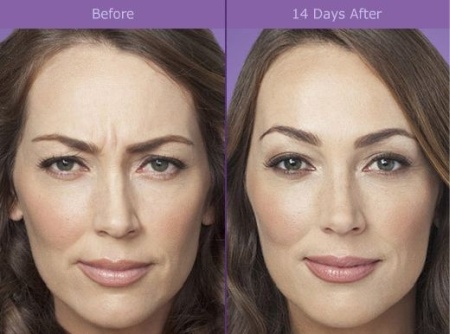25 facts about plastic surgery
 Bashny.Net
Bashny.Net

The most popular procedure in cosmetic surgery is pumping muscles Botox (protein obtained their botulinum toxin). It is injected into the skin to paralyze facial muscles, giving the patient a smooth skin. Effect of treatments usually disappears after 3-6 months after surgery.
The first record of "curvature of the nose" is found in the ancient Indian Sanskrit texts (600 BC). Doctors reconstructed human nose, cutting the skin or in the cheek or forehead, twisted the skin at the appropriate place and sutured. Two polished wooden tubes inserted into the nostrils to keep the air passages during treatment.
The word "plastic" comes from the Greek «plasikos», which means "form." The term "operation" is inherited from the Greek word «kheirourgos», ie «kheir» - hand + «ergon» - work.
In the first century BC, the Romans practiced various types of plastic surgery to reconstruct the nose, eyes, lips and teeth. The Roman physician Cornelius Celsus (b. 25 BC - d. 50 AD) also describes the procedures that were used to cut or even breast reduction in men.
The most popular surgical procedure in ancient Rome was the removal of scars, in particular, the scars on his back, which had been signs of shame, because they are supposed escape of a person from the battlefield, or is likely to mark slaves. Foreigners also used the services of plastic surgeons to better fit into Roman society.
In the Middle Ages, plastic surgery is usually associated with pagan or sinful behavior, because the shedding of blood during surgery was like magic.
When plastic surgery became popular during the Renaissance, surgeons began for skin grafts from different donors (animals), such as neighboring pig, but were confused when the new authorities began to dry up and fall off. They concluded that the transplanted organ dies immediately after the death of the owner.
Many medical operations at the beginning of the Renaissance took place in hairdressing premises.
Italian Gaspare Talyakotstsi (rod.1546 - um.1599) many consider the "father of modern plastic surgery." The text of his book «De curtorum chirugiau» noted the need for surgical intervention because of the duels or street fighting, as well as a widespread outbreak of syphilis, which destroyed the nose. The "virtual" nose, however, may fall inside, if the patient was breathing too hard, and young women with reconstructed noses could hardly become the object of desire in men.
Talyakotstsi was atypical plastic surgeon in the Renaissance, because it does not consider the disease, such as syphilitic nose as divine punishment. Instead, he used the vocabulary of humanists such as Pico della Mirandola, Giovanni Francesco (1463-94), to justify their surgical innovations in the new independent operations. Developments Talyakotstsi disappeared, mainly as a result of the Counter-Reformation.
Karl Ferdinand Graefe (1787 - 1840) coined the term "plastic surgery" in his text «Rhinoplastik» 1818. He also tried to remove the moral stigma associated with the reconstruction of the nose, giving the name of the procedure - rhinoplasty to make it more similar to other surgical procedures.
Surgeons who served in the First World War, created by the American Association of Plastic Surgeons in 1931 and helped the government to restrict illegal surgery. They are the largest medical organization dedicated to plastic surgery in the world.
During the Second World War has been made many discoveries in plastic surgery, which included the restoration of all extremities, extensive skin grafts, microsurgery, antibodies, and increased knowledge about the health of tissues.
Silicone breast implants have become popular in the 1960s. In the women's breasts injected liquid silicone - a substance that was originally used by the Japanese during World War II. Unfortunately, the implants can provoke side effects, such as a mastectomy as a result of infection and guaranteed "suspended" his chest for 40 years.
In Nazi Germany, some types of reconstructive procedures were designed to ensure that soldiers with "too ugly" appearance became "real" soldiers. Benito Mussolini (b. 1880 - um.1945) also use plastic surgery to increase the performance of officers with "corrections" lowering eyelids.
The first breast enlargement surgery performed Vincent Czerny, November 24, 1893 in Heidelberg, Germany. His patient was a 41-year-old singer, who was unhappy with the size of their breasts. Fortunately, the patient had tumors (lipomas) on the back that Vincent has collected and transplanted into her chest. It was released December 20, 1893.
In 1998, Bill Clinton signed the bill, according to which insurance companies must cover all costs of operation for breast reconstruction for women who have had a mastectomy.
In 2007, there were more than 11, 5 million plastic surgeries, in comparison with the year 2000 - an increase of 50%. The total number of procedures using plastic surgery increased by 457%.
In 2007, the most popular surgery for men and women was the liposuction procedure.
Women accounted for 91% of patients for plastic surgery in 2007.
Two-thirds of plastic surgery patients - people who have already made themselves at least one operation in the field of medicine, and remained indifferent. One example of such a change, depending on the body is a 48-year-old Hang Myoko, which disfigured his face with hot vegetable oil, to make a new commitment to change the skin.
Americans spent $ 13, $ 2 billion on plastic surgery in 2006.
Modern plastic surgeons explores the potential and opportunities in cloning technology as a method of rejuvenating the body, and learn the secrets of the growth of the child in the womb, where the healing of scars and inaccuracies in the outer coating of the skin of the future baby.
Tags
See also
15 people who turned themselves in dolls
Interesting facts about the Bermuda triangle
Facts of Life Iman
As stars age
Scientific facts - is popular to the masses!
Top 10 facts about the Chinese Internet
Celebrities who benefited plastic
12 amazing facts about your digestive system
15 well-known "facts" that actually are not any facts
















